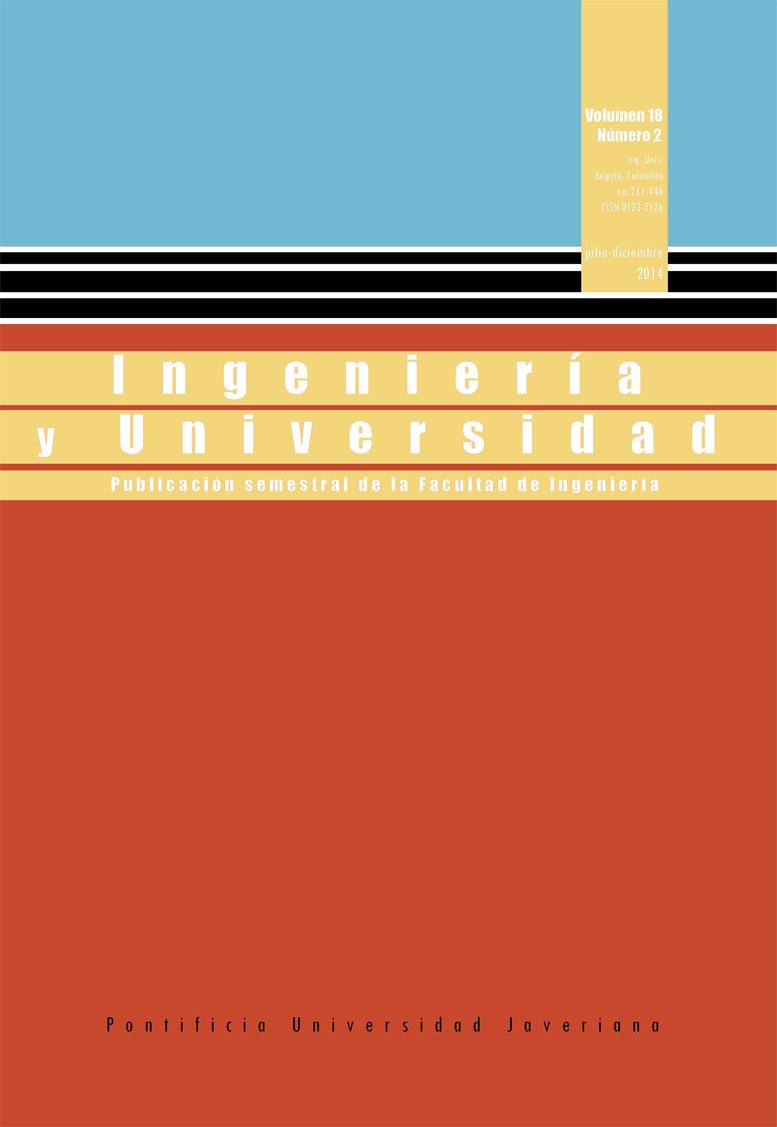Computer vision system for the optimization of the color generated by the coffee roasting process according to time, temperature and mesh size
##plugins.themes.bootstrap3.article.details##
This article describes the implementation of a computer vision system to determine the effect of time and temperature on the color generated by the roasting of coffee, for which a software tool in the mathematical software Matlab, previously parameterized using color data for the roasting process was developed and implemented. The color was measured in CIEL*a*b* space and the data were analyzed using the statistical response surface design. The result of this work is a system that allows for realtime sensory information about color and therefore has an advantage over existing traditional systems. The study shows that computer vision system could distinguish different shades during roasting of coffee depending on process parameters and good capacity for generalization.
Computer vision system, CIEL*a*b*sistema de visión artificial, CIEL*a*b*
ADAMS, A.; BORRELLI, R.; FOGLIANO, V. and DE KIMPE, N. (2005). Thermal degradation studies of food melanoidins. Journal of Agricultural and Food Chemistry. 2005, vol. 1, no. 10, pp. 4136-4142.
BROSNAN, T. and SUN D.-W. Improving quality inspection of food products by computer vision: a review. Journal of Food Engineering. 2004, vol. 61, pp. 3-16.
COMMISSION INTERNATIONALE DE L’ÉCLAIRAGE. Colorimetry (2da ed.). Vienna, Austria: Central Bureau of the CIE, 1986.
ESCOFET, J.; MILLÁN, M.S.; NAVARRO, R. and NESTARES, Ó. Device and computer visión procedures to measure and characterize the distribution of color in a sample [document on line]. Barcelona, 2005. http://digital.csic.es/bitstream/10261/8398/1/2208076_B1.pdf [consulta: 01-09-2012].
HERNÁNDEZ, J.A.; HEYD B. and TRYSTRAM, G. Predicition of bringhtness and Surface area kinetics during coffee roasting. Journal of Food Engineering [article on line]. 2008.
HERNÁNDEZ, J.A.; HEYD, B.; IRLES, C.; VALDOVINOS, B. and TRYSTRAM, G. Analysis of the heat and mass transfer during coffee batch roasting. Journal of Food Engineering. 2007, vol. 78, pp. 1141-1148.
HEYD, B.; BROYART, B.; HERNÁNDEZ, J.A.; VALDOVINO-TIJERINO, B. and TRYSTRAM, G. Physical model for the heat and mass transfer in the coffee roasting. Drying Technology. 2007, vol. 61, no. 6-7, pp. 212–222.
GARCÍA, E. and AYUGA, F. Design and construction of food processing industries (1st ed.). n. p.: Mundi Prensa, 1993.
GOMES, J.F.S. and LETA, F.R. Applications of computer vision techniques in the agriculture and food industry: A review. European Food Research and Technology. 2012, vol. 235, no. 6, pp. 989-1000.
JIMÉNEZ, H.; CORREA, B.; DIEZMA, V.; DÍAZ, B.; MENESES, B. and OTEROS, R. Study techniques for quality monitoring and classification of roasted coffee beans: analysis of new technologies [document on line]. Presented at VI Iberian Congress Agricultural Engineering, Portugal: Universidad de Évora. 2011.
LÓPEZ-GALILEA, I.; FOURNIER, N.; CID, C. and GUICHARD, E. Changes in headspace volatile concentrations of coffee brews caused by the roasting process and the brewing procedure. Journal of Agricultural and Food Chemistry. 2006, vol. 54, no. 22, pp. 8560-8566. DOI: 10.1021/jf061178t.
PATEL, K.K.; KAR, A.; JHA, S.N. and KHAN M.A. Machine vision system: A tool for quality inspection of food and agricultural products. Journal of Food Science and Technology—Mysore. 2012, vol. 49, no. 2, pp. 123-141.
PATHARE, P.B.; OPARA, U.L. and AL-SAID, F.A. Colour measurement and analysis in fresh and processed foods: A review. Food and Bioprocess Technology. 2013, vol. 6, no. 1, pp. 36-60.
SACCHETTI, G.; DI MATTIA, C.; PITTIA, P. and MASTROCOLA, D. Effect of roasting degree, equivalent thermal effect and coffee type on the radical scavenging activity of coffee brews and their phenolic fraction. Journal of Food Engineering. 2009, vol. 90, no. 1, pp. 74-80. DOI: 10.1016/j.jfoodeng.2008.06.005.
SANDOVAL, Z. Characterization and classification of cherry coffee using artificial vision [document on line]. Bogotá: Universidad Nacional de Colombia, 2005.
SUMMA, C.; DE LA CALLE, M.; BROHEE, M.; STADLER, R. and ANKLAM, E. Impact of the roasting degree of coffee on the in vitro radical scavenging capacity and content of acrylamide. Joint Research Centre [article on line]. 2007.
TEENA, A.; MANICKAVASAGAN, A.; MOTHERSHAW, A.; EL HADI, S. and JAYAS, D.S. Potential of machine vision techniques for detecting fecal and microbial contamination of food products: A review. Food and Bioprocess Technology. 2013, vol. 6, no. 7, pp. 1621-1634.
WU, D. and SUN, D.W. Colour measurements by computer vision for food quality control: A review. Trends in Food Science & Technology. 2013, vol. 29, no. 1, pp. 5–20.
ZHENG, C.X.; SUN, D.W. and ZHENG L.Y. Recent developments and applications of image features for food quality evaluation and inspection: A review. Trends in Food Science & Technology. 2006, vol. 17, no. 12, pp. 642-655.


